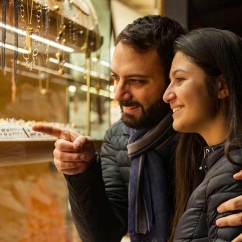Jewelry ECOMM Tech
How To Enhance The Jewelry Retail Experience April 22, 2019 (0 comments)

Knowing the four C’s isn’t just enough when you run a jewelry retail business. Customers want memorable experiences and great stories that they can share with their loved ones.
In this article, we’ll go through several emerging technologies that will enhance the jewelry retail experience.1. Hand Photography
On the spot jewelry photography is a new retail concept being discovered by Picup Media. Quite often many customers walk into a jewelry store to see what’s available. At the same time, the customer would want to see how a piece of jewelry would look if they were to wear it. Once again, the biggest problem with jewelry is that is difficult to capture the beauty and details and color. We’ve all seen the videos on Instagram where a beautiful hand has a beautiful (if not multiple rings). However, you’ll notice that the sparkles are lacking and the facets cannot be seen. Introducing GemLightbox, the world’s first smartphone jewelry lightbox. The lighting conditions have been perfected for jewelry photography so that metals look nice and shiny, while gemstones retain their true color and appear sparkly. GemLightbox has been designed so that anyone with a smartphone can capture studio quality images in a matter of seconds. Yes, that’s right, this includes your staff and the customers! The front opening cavity of GemLightbox is large enough so that you can place a whole hand inside. Once placed inside, users can capture an image or video from the top. Add a bit of personal branding inside GemLightbox and your customers will never forget who you are.
This results in the perfect hand photograph or video that be instantly shared onto social media, or shared with family and friends. Having the ability to shoot photos and record videos at any given time allows for a faster sales cycle. Your customers have just witnessed and captured the piece of jewelry in its best possible form. Below are some hand photography images already used by existing GemLightbox customers.
The front opening cavity of GemLightbox is large enough so that you can place a whole hand inside. Once placed inside, users can capture an image or video from the top. Add a bit of personal branding inside GemLightbox and your customers will never forget who you are.
This results in the perfect hand photograph or video that be instantly shared onto social media, or shared with family and friends. Having the ability to shoot photos and record videos at any given time allows for a faster sales cycle. Your customers have just witnessed and captured the piece of jewelry in its best possible form. Below are some hand photography images already used by existing GemLightbox customers.

2. Engagement Ring Photography
Customers want to capture the journey of their engagement ring, starting from inception, during the manufacturing process and delivery.a.) Inception
This is the conceptual phase where both the jeweler and customer meet to discuss and choose a design. This phase is a huge opportunity to capture the start of the journey for both the customer and the piece of jewelry to be created. For example, if a customer wanted to design an engagement ring for their partner, the jeweler could capture the moment by recording a video of both of themselves in a quick interview style format. Inside the interview, the customer can talk the backstory to their relationship, and discuss potential designs the partner would like and why. This same video content can be used eventually at the wedding day where it can be shared with family and friends.b.) Manufacturing
The materials for the ring is then sourced, and progress shots are made. This is usually done at the back on the office Progress shots make great social media posts, and helps with the communication between the jeweler and the customer. The GemLightbox is a perfect tool during the jewelry manufacturing as the bench jeweler can easily take snaps with little effort in setting up. The interior photography table can also be cleaned very easily using any cleaning agents, making black marks not an issue.
c.) Delivery
Finally, once the engagement ring is completed, the final photographs can be shot and the rest of the content compiled together to tell one part of a bigger story.3. Mobile Interactivity
Luxury retailer jewelers such as Monica Rich Kosann have created personalized shopping experiences whereby they have brought the online retail experience in physical stores. Customers can browse and interact with the whole inventory of the store on Elo touchscreens to facilitate hands-on shopping between customers and associates. The technology also allows for customization and data collection which can be later used for sales campaigns and marketing research. Shoppers are empowered by having limitless options and are engaged by visuals to create a better customer experience.
4. Augmented Reality
Augmented reality enables customers to visualize a piece of jewelry without the product actually being there. Notable luxury giants Tiffany & Co. & Blue Nile have introduced augmented reality to their customers’ retail shopping experience by through their own mobile phone application, powered by Tryon Guru. The technology allows for greater engagement through push notifications, in-app deals and the monitoring of customer behaviours. The augmented reality retail experience will continue to progress as well as mobile technology in general.


